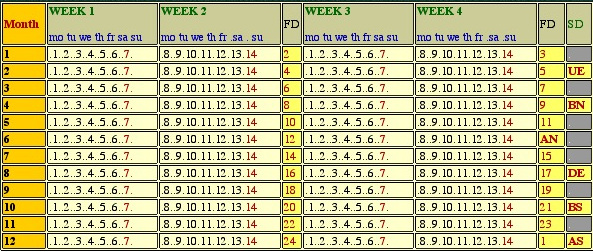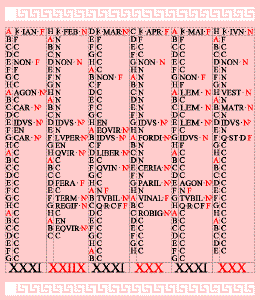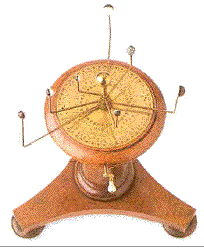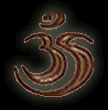
The
Hindu Symbol for the Pranava AUM
central for meditating the natural
order
Table
2: The
Cakra calendar.
 Cakra
is Sanskrit for wheel or disc and refers to the
spinning celestial sky that can be observed as having
the form of a so called Sisumâra
or
dolphin, that is the Milky Way. The word also relates
to the cyclic of time in general; the time that makes
patterns like the solar year with its seasons and the
lunar month with its phases. Thus we have the
cakra
order,
wich is the order of the cyclic time
in nature of the sun, the moon and the stars at the
one hand, and a cakrakalendar which displays this
order on a solar calendar with a division derived from
the moon at the other hand. The name cakra is inspired
on passages in the vedic literature, knowing the
Bhâgavata Purâna (see
Canto
3 chapter 11),
that refer to the celestial sky (see footnote*)
because that is the form of the Lord and God that is
visible in nature. The (because of transposition
almost) perfectly regular Cakra calendar
divides the year in 24 periods of fifteen days making
48 weeks with 24 FD fifteenth days and five SD season
days. The calendar starts of at the astronomically
shortest day of the 22nd of Dec., making its first
working-day of the year the 23rd of the gregorian dec.
(N.B: Christmas was originally celebrated at old- and
newyear's day. For more technical details to the
instrumental respect of this see designs.). Cakra
is Sanskrit for wheel or disc and refers to the
spinning celestial sky that can be observed as having
the form of a so called Sisumâra
or
dolphin, that is the Milky Way. The word also relates
to the cyclic of time in general; the time that makes
patterns like the solar year with its seasons and the
lunar month with its phases. Thus we have the
cakra
order,
wich is the order of the cyclic time
in nature of the sun, the moon and the stars at the
one hand, and a cakrakalendar which displays this
order on a solar calendar with a division derived from
the moon at the other hand. The name cakra is inspired
on passages in the vedic literature, knowing the
Bhâgavata Purâna (see
Canto
3 chapter 11),
that refer to the celestial sky (see footnote*)
because that is the form of the Lord and God that is
visible in nature. The (because of transposition
almost) perfectly regular Cakra calendar
divides the year in 24 periods of fifteen days making
48 weeks with 24 FD fifteenth days and five SD season
days. The calendar starts of at the astronomically
shortest day of the 22nd of Dec., making its first
working-day of the year the 23rd of the gregorian dec.
(N.B: Christmas was originally celebrated at old- and
newyear's day. For more technical details to the
instrumental respect of this see designs.).

|
Yellow
fields:
fifthteenth
day
(FD)
and
season-days (SD)
Red
letters: cakra-weekends
SD:
:
beginning of the six seasons
UE:
upward along the equinox (spring in the northern
hemisphere)
BN:
before the northern solstice (early summer in the
northern hemisphere)
AN
after the northern solstice (late summer in the
northern hemisphere)
DE:
downward the equinox (autumn in the northern
hemisphere)
BS:
before the southern solstice (early winter in the
northern hemisphere)
AS
: after the southern solstice (late winter in the
northern hemisphere)
*
: gregorian leapday in February : leaps 21 dec. for
the Cakra-calendar

The
division in 15 day fortnights is taken from the
Bhâgavata Purana, and
the seven days division of the christian custom is
taken from the Holy
Bible.
The
calendar starts at the 22nd of December at AS,
making 1/1 (the first day, first paksah or
fortnight)
the first working day 23rd of Dec.
For
a match of this calendar with the actual dates go
the the Full
Calendar of Order.
|
The
original
vedic division
doesn't mention weeks as given in this table, but
specifies only up to a fortnight paksah that
jumps from that to the division of the day. The cakra
week is derived from the christian custom of
celebrating days of rest and works like a
transposition of the lunar order to the tropical year.
Therefore this calendar is to be considered
vedic/roman, that is to say as roman to the concept of
the 7-days calendar reform of Constantine the Great in
the A.D. 321 who turned the solar order of the julian
reform of 45 B.C. into a linear order of the week.
With the cakra order is offered a rationalized
indication of as well the ancient vedic as the old
julian order which, with the respect for the
renaissance
reform of Pope Gregory of
1582-1583,
does not depend on someones position on earth, except
of course for the normal dat-line of the gregorian
calendar which stays the foundation of it.
The
lenght of the months is not set as in India to 30
degrees of the ecliptic or rasi's, but is to the old
roman tradition, settled as an equal mathematical
division for purposes of regularity and
measure.
In
India one traditionally - but not formally - derives
the beginning of the socalled nirayana year
from the position of a fixed star called Chitra, but
since the Bhâgavata Purâna speaks
of a tropical year, is this calendar starting with the
22nd of Dec. at the beginning of one cylce of the sun
going south and north, thus right after the shortest
day.
The
celestial sky is respected with a
20 min./year forward progressing reference
day
(a
galactic new year)
which, on the Full
calendar of Order
(the cakra-calendar plus the lunar phases), describes
the position of the earth as closest to the center of
the galaxy.
(source: see S'rîmad
Bhâgavatam C3 ch 11)
The
advantage of the Cakra-calendar lies in
:
 1)
The
regular division of the
year.
This is especially suited for formal business like
collecting taxes, running a company or for collecting
statistics. 1)
The
regular division of the
year.
This is especially suited for formal business like
collecting taxes, running a company or for collecting
statistics.
 2)
The
lack of an
accord of dates with
days,
a traditional point of criticism concerning the
gregorian calendar, because of which one is in fact
constantly confused about which day is what date , is
overcome with this division. One's birthday e.g. will
always be on the same day of the week with this
calendar. (precession to the celestial sky of 1
day/seventy-one years not included). 2)
The
lack of an
accord of dates with
days,
a traditional point of criticism concerning the
gregorian calendar, because of which one is in fact
constantly confused about which day is what date , is
overcome with this division. One's birthday e.g. will
always be on the same day of the week with this
calendar. (precession to the celestial sky of 1
day/seventy-one years not included).
 3)
In
principle there will be the leaping of one day as soon
as the calendar deviates - on the average- for more
than a day from the real position of the sun (at the
wintersolstice) that stands for the end of the
astronomical year (set on the 22 dec. for civil
purposes but in reality fluctuating around that mean
date) and the passage of the seasons. Thus the
authority over this calendar lies with the astronomers
and not with politicians and religious people, so as
to have less arbitrariness and more method and logic
in the time system. Practically one will follow the
leaping procedure of the gregorian calendar (every
four years a day except for a day to the 'centurion'
rule) under the consideration that 1) the leapday will
be added normally at the end of the astronomical year
and that 2) as soon as after about 1250 years after
the introduction of that calendar, when the deviation
is more than half a day , the calendar will be leaped
extra in order not to deviate for more than one day at
the most. Thus the
objection is taken away against the deviation of the
leaping procedure of the gregorian
calendar. 3)
In
principle there will be the leaping of one day as soon
as the calendar deviates - on the average- for more
than a day from the real position of the sun (at the
wintersolstice) that stands for the end of the
astronomical year (set on the 22 dec. for civil
purposes but in reality fluctuating around that mean
date) and the passage of the seasons. Thus the
authority over this calendar lies with the astronomers
and not with politicians and religious people, so as
to have less arbitrariness and more method and logic
in the time system. Practically one will follow the
leaping procedure of the gregorian calendar (every
four years a day except for a day to the 'centurion'
rule) under the consideration that 1) the leapday will
be added normally at the end of the astronomical year
and that 2) as soon as after about 1250 years after
the introduction of that calendar, when the deviation
is more than half a day , the calendar will be leaped
extra in order not to deviate for more than one day at
the most. Thus the
objection is taken away against the deviation of the
leaping procedure of the gregorian
calendar.

Stonehenge
at sunset
It is one of the first western observatories
Originally it probably had a heavy religious
connotation.
 4)
The
fourth advantage the calendar offers is having
the
same division for the year as for the
day
because of which a more comprehensive clock-design is
possible. This way one can equal 24 fifteenday periods
(48 weeks) to 24 hours on a scale which with a year of
52 weeks is not possible (see designs).
One does get hours of 48 minutes (and minutes with 48
seconds) which is then a logical consequence of having
one and the same division for all phenomena of
time. 4)
The
fourth advantage the calendar offers is having
the
same division for the year as for the
day
because of which a more comprehensive clock-design is
possible. This way one can equal 24 fifteenday periods
(48 weeks) to 24 hours on a scale which with a year of
52 weeks is not possible (see designs).
One does get hours of 48 minutes (and minutes with 48
seconds) which is then a logical consequence of having
one and the same division for all phenomena of
time.
 5)
A
regular
division of the solar year in 48 weeks for work (with
six working days of preferably six hours) offers next
to the fixation of days on dates thus also the
advantage of having a
stable structure of the
weekorder
on the calendar. This makes it more easy to plan days
for a holiday, days off from work and days for study
and building good habits with them. Above that the 48
weekrhythm with six workingdays offers a more relaxed
tempo of life with shorter days of work for a 36-hour
workweek than a 52 week rhythm with an 40-hour
workday. By having a long weekend every 14 days and a
three-day weekend each two month's except for the
middle of the summer this way it can be precluded that
holidays are mandatory for ones health as a
consequence of which that way one is less destructive
concerning the continuity of societal services (for a
nineteen days holiday one only has to take ten days
off given the end of a 'Cakra' -season and a working
week of five-days) . Respecting both calendars at the
same time will make any job a 30-hour part-time job,
see 5d
& 5q
or about
The Order of Time
for a short explanation. 5)
A
regular
division of the solar year in 48 weeks for work (with
six working days of preferably six hours) offers next
to the fixation of days on dates thus also the
advantage of having a
stable structure of the
weekorder
on the calendar. This makes it more easy to plan days
for a holiday, days off from work and days for study
and building good habits with them. Above that the 48
weekrhythm with six workingdays offers a more relaxed
tempo of life with shorter days of work for a 36-hour
workweek than a 52 week rhythm with an 40-hour
workday. By having a long weekend every 14 days and a
three-day weekend each two month's except for the
middle of the summer this way it can be precluded that
holidays are mandatory for ones health as a
consequence of which that way one is less destructive
concerning the continuity of societal services (for a
nineteen days holiday one only has to take ten days
off given the end of a 'Cakra' -season and a working
week of five-days) . Respecting both calendars at the
same time will make any job a 30-hour part-time job,
see 5d
& 5q
or about
The Order of Time
for a short explanation.
 6)
The
objection against the christian
count
of years
is that it has no year zero and that one works with
counting backwards from a certain date (from A.D. to
B.C.) to periods of roman and greek history we do
count to the continuity of our civilization. This
objection can be overcome by setting the
Cakra-calendar to the so called cultural swa-dharma
(our own nature) which implies that one switches back
to the original yearcount of ancient Rome A.U.C.,
Ab Urbe condita , which means "from the
foundation of the city". This yearcount is set to 753
B.C. , so that, according the swa-dharma of the Cakra
calendar the year 2000 is set on 2753. 6)
The
objection against the christian
count
of years
is that it has no year zero and that one works with
counting backwards from a certain date (from A.D. to
B.C.) to periods of roman and greek history we do
count to the continuity of our civilization. This
objection can be overcome by setting the
Cakra-calendar to the so called cultural swa-dharma
(our own nature) which implies that one switches back
to the original yearcount of ancient Rome A.U.C.,
Ab Urbe condita , which means "from the
foundation of the city". This yearcount is set to 753
B.C. , so that, according the swa-dharma of the Cakra
calendar the year 2000 is set on 2753.

The
roman calendar after it was tuned to the solar
year
transposing the lunar order as does the
cakracalendar,
but , due to cultural customs, without being
as regular as the cakracalendar .(Source)
 7)
The
objection of intercalary months and the cultural
manipulation and arbitrariness about it respecting the
positions of the moonphases in Muslim and Hindu
calendars is taken away by connecting the Cakra
calendar to a full concept of calendar-order
(see
the coloring of the
correctiontable)
by means of which as well the existing gregorian
division of the year, a mooncalendar divided in real
moon'weeks' (to astronomical measures of the
moonphases), as a rational solar calendar (the
Cakra-calendar itself) is being used in a way that has
respect
for the discrete function of each calendar
division.
This means that each division can be utilized for the
purpose it is most suited for: the reformed roman
julian/gregorian) solar calendar for the length of the
solar year and the traditional naming of dates, the
Cakra calendar for a logical regular and scripturally
founded division in working weeks and the lunar
calendar for a studious contemplation on the
naturalness of such a cultural fixation in seven
day-weeks (traditionally the moon symbolizes the world
of books and thus one can settle discretely for ones -
non-fruitive - days of study with this calendar). This
gives a differentiated cultural image of time that is
suited better for (religious) cultures in the world
who respect the lunar calendar as well as for the
other half of the world that sticks to a (political)
division according the seasons. By all means one may
speak to this complete concept of calendrical order of
a
participation of the Cakra-calendar in a multicultural
worldcalendar.
(for further information about the practical use
of this complete concept of order, see
below
the correction table). 7)
The
objection of intercalary months and the cultural
manipulation and arbitrariness about it respecting the
positions of the moonphases in Muslim and Hindu
calendars is taken away by connecting the Cakra
calendar to a full concept of calendar-order
(see
the coloring of the
correctiontable)
by means of which as well the existing gregorian
division of the year, a mooncalendar divided in real
moon'weeks' (to astronomical measures of the
moonphases), as a rational solar calendar (the
Cakra-calendar itself) is being used in a way that has
respect
for the discrete function of each calendar
division.
This means that each division can be utilized for the
purpose it is most suited for: the reformed roman
julian/gregorian) solar calendar for the length of the
solar year and the traditional naming of dates, the
Cakra calendar for a logical regular and scripturally
founded division in working weeks and the lunar
calendar for a studious contemplation on the
naturalness of such a cultural fixation in seven
day-weeks (traditionally the moon symbolizes the world
of books and thus one can settle discretely for ones -
non-fruitive - days of study with this calendar). This
gives a differentiated cultural image of time that is
suited better for (religious) cultures in the world
who respect the lunar calendar as well as for the
other half of the world that sticks to a (political)
division according the seasons. By all means one may
speak to this complete concept of calendrical order of
a
participation of the Cakra-calendar in a multicultural
worldcalendar.
(for further information about the practical use
of this complete concept of order, see
below
the correction table).
 8)
The
modern concept of time-consciousness has the objection
that it makes a system that is unscientific and
arbitrary to the natural order in making for
weekorders going against a year order without a
fixationpoint and a summertime that goes against the
times for winter on historically pagan (commercial
profit-, and political pragmatical priority
perversion-) motives (see the political
Constantine 321 A.D.
adopting the fixed weekorder from the Babylonian pagan
tradition not realizing that a seven days week should
not necessarily be followed immediately by another
seven days period without the interposition of
(already known lunar-) signal days that can be used as
a corrective measure to the natural order - God's
order). With the Cakra calendar
the
concept of consciousness is led back to the
authority and dynamics of discrete natural
events
that make for their own ('God-ordained') natural
alternations and consciousness of rhythm. Thus mankind
can cure from its cultural standardtime neurosis of
control and collective psychotic bouts of irrational
warfare of having fallen and having lost the control
in the ignorance of oppositions and conflicts over
religious, scientific and thus also political
paradigmatic authority . 8)
The
modern concept of time-consciousness has the objection
that it makes a system that is unscientific and
arbitrary to the natural order in making for
weekorders going against a year order without a
fixationpoint and a summertime that goes against the
times for winter on historically pagan (commercial
profit-, and political pragmatical priority
perversion-) motives (see the political
Constantine 321 A.D.
adopting the fixed weekorder from the Babylonian pagan
tradition not realizing that a seven days week should
not necessarily be followed immediately by another
seven days period without the interposition of
(already known lunar-) signal days that can be used as
a corrective measure to the natural order - God's
order). With the Cakra calendar
the
concept of consciousness is led back to the
authority and dynamics of discrete natural
events
that make for their own ('God-ordained') natural
alternations and consciousness of rhythm. Thus mankind
can cure from its cultural standardtime neurosis of
control and collective psychotic bouts of irrational
warfare of having fallen and having lost the control
in the ignorance of oppositions and conflicts over
religious, scientific and thus also political
paradigmatic authority .
 9)
The
calendar division of 48 weeks matches the division in
moonphases on a lunar calendar. Thus there
is
a better accord of this solar calendar with the
mooncalendars
the other half of mankind uses (and were used by
ourselves before the reformation of Caesar 45 BC), as
far as the rhythm is concerned. This makes it better
possible to compare and live with both the calendars
at the same time offering two more or less equal
events - a moon-phase and a weekend-in the same period
of time. This is also favorable for a mondial
timeorder in respect of both calendars/types of
time-culture. 9)
The
calendar division of 48 weeks matches the division in
moonphases on a lunar calendar. Thus there
is
a better accord of this solar calendar with the
mooncalendars
the other half of mankind uses (and were used by
ourselves before the reformation of Caesar 45 BC), as
far as the rhythm is concerned. This makes it better
possible to compare and live with both the calendars
at the same time offering two more or less equal
events - a moon-phase and a weekend-in the same period
of time. This is also favorable for a mondial
timeorder in respect of both calendars/types of
time-culture.

Early
19th century clock indicating
the positions of the sun and
planets.
Note:
Stardate calendar or Cakra-calendar does not mean that
this calendar runs to the stars. For the word cakra
refers also to other cyclic movements of individual
celestial bodies or luminaries in the forcefield of the
ether. The precession, the shift of the celestial sky,
is, with the originally complicated design of
the
Cakra-tempometer
and the Full
Calendar of Order,
respected by means of a so-called 'birthday of the sun' -
or ones own birthday for that matter -, which
according
the astronomical
zodiac
relative to the center of the galaxy (in Sagittarius-A)
shifts with one day in the 71
years (about 20 minutes a
year)
on a solar calendar like the normal gregorian one we have
in civil use. The calendar is also called stardate
because of the fact that it is derived from the way de
Veda's (the so-called fifth Veda or purana's.) respect
the celestial sky with a division of the (solar-)year in
24 so-called paksah's or pancha dasa's (15-day) periods
(source: see Bhagavatam).
The original
design of the
tempometer
therefore shows a scale-division of 366 stardays in stead
of 365 solar days (a later
version simply sets the clock to the
sun).
Vedically is the year (a so-called vatsara) defined by
the north-south-movement of the sun (set to the seasons
thus or 'tropical' of nature). Therefore ultimately the
Cakra- calendar is a transposition of the, by the moon
inspired, division of the celestial sky (the
zodiak)
to a division of the solar year, with which one , halfway
the year, loses a day at the one hand. At the other hand
it is in fact the transposition of the lunar calendar to
the solar one, something which was also practiced by the
julian calendar reform 45 B.C. , but was abolished in 325
A.D. by the first christian roman emperor Constantine the
Great (before his conversion), the founder of the
christian roman empire of Byzantium (with its as its
capital Constaninopel).With the introduction by him of
the linear order of the week for the civil society that
was after an easy lunar management, was this calendar
thus forgotten. De cakra-kalender may be considered the
vedic restauration of our own classical roman respect of
nature thus. For the technical respect for the difference
between stardate and solardate days, see
designs/stardate
disc.
Previous
Page
| To
the Full Calendar of
Order
Links:

©2001
theorderoftime
|





 Cakra
is Sanskrit for wheel or disc and refers to the
spinning celestial sky that can be observed as having
the form of a so called Sisumâra
or
dolphin, that is the Milky Way. The word also relates
to the cyclic of time in general; the time that makes
patterns like the solar year with its seasons and the
lunar month with its phases. Thus we have the
Cakra
is Sanskrit for wheel or disc and refers to the
spinning celestial sky that can be observed as having
the form of a so called Sisumâra
or
dolphin, that is the Milky Way. The word also relates
to the cyclic of time in general; the time that makes
patterns like the solar year with its seasons and the
lunar month with its phases. Thus we have the



